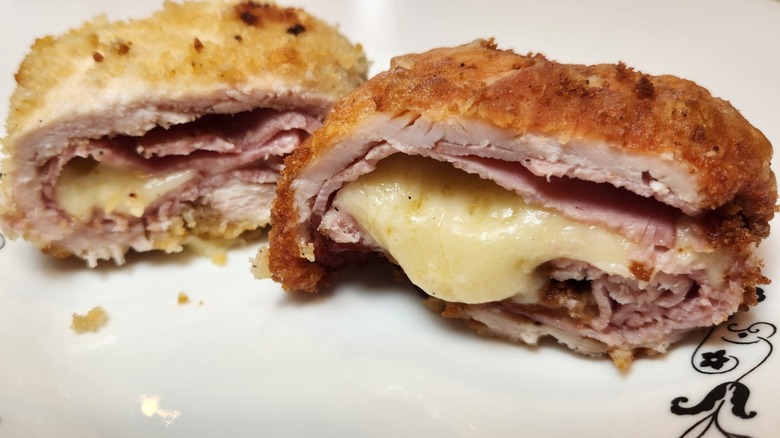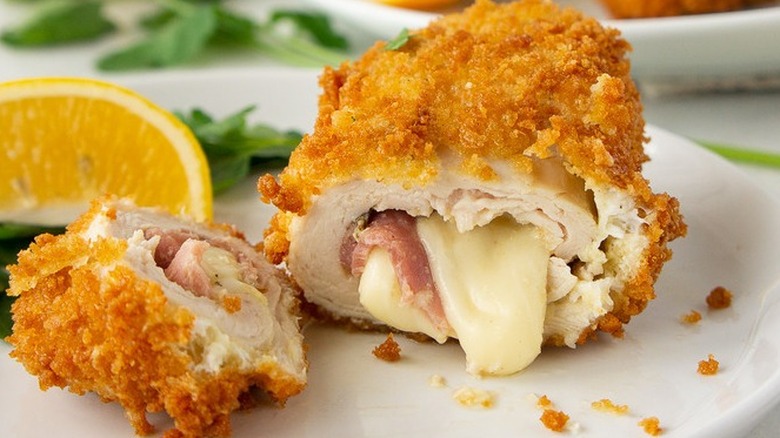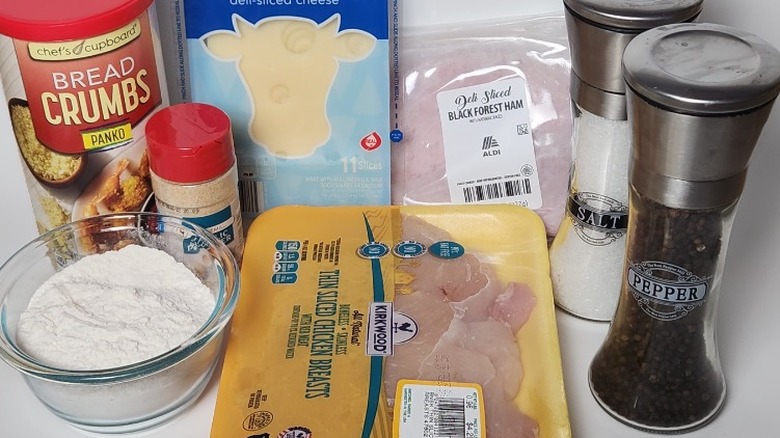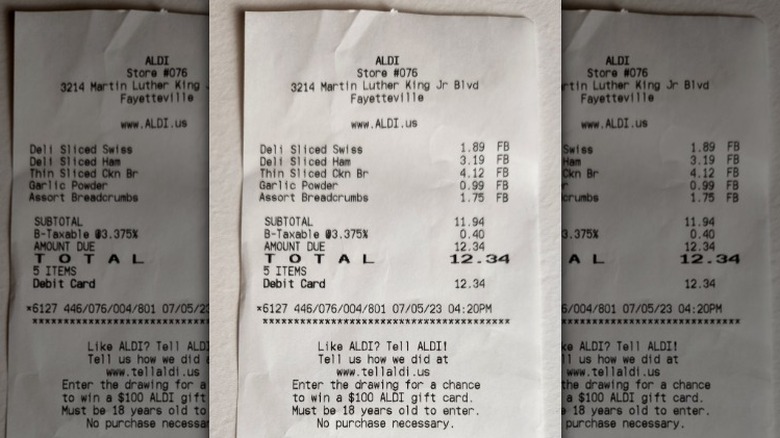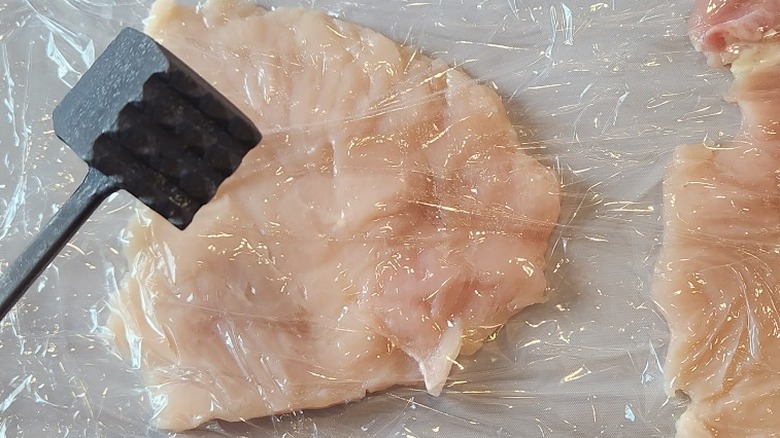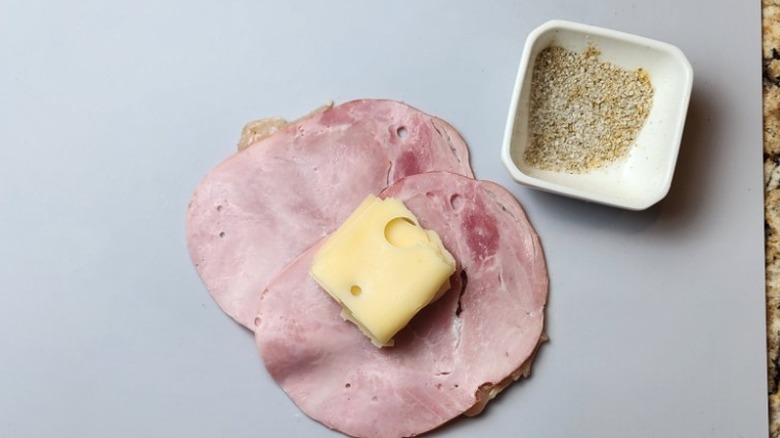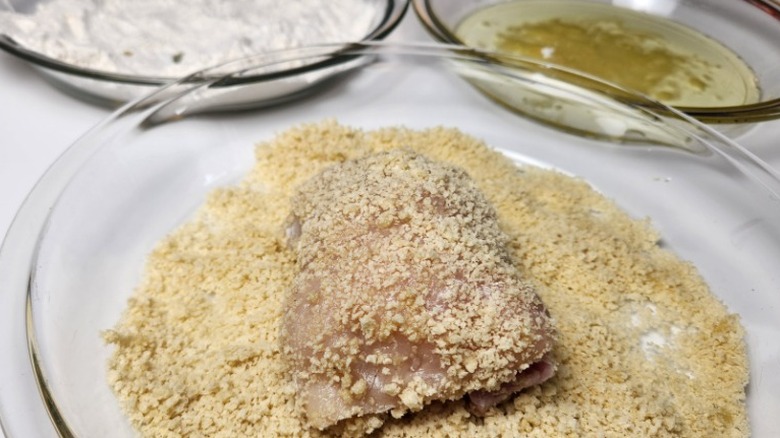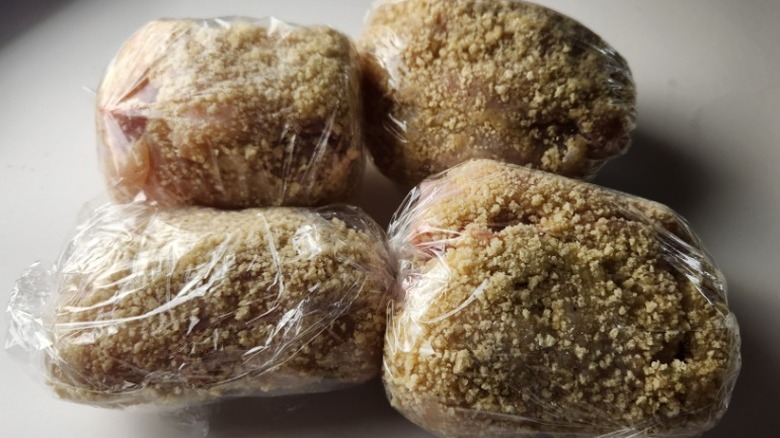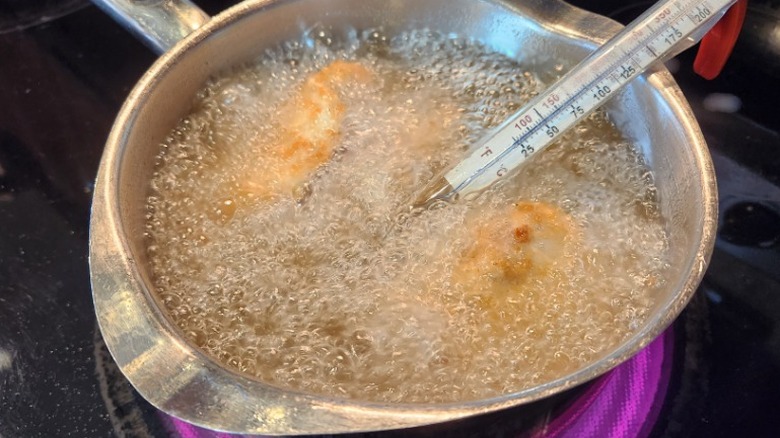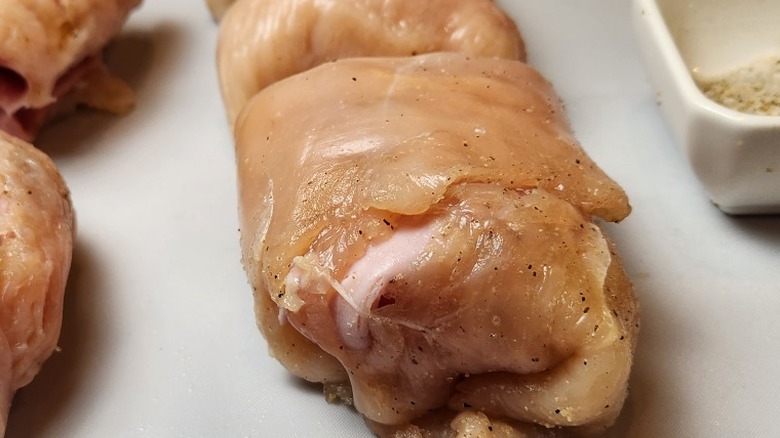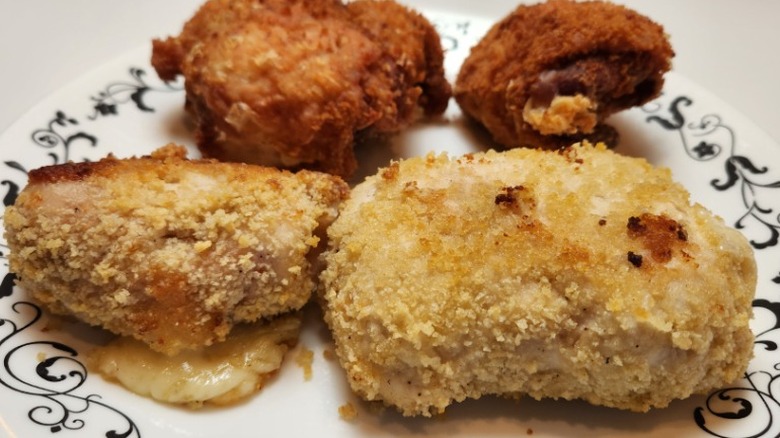We Tried To Make Chicken Cordon Bleu With A $12 Aldi Shopping Budget
The prospect of making a classy meal like chicken cordon bleu on a budget can be daunting. While being able to make a recipe exactly as written is nice, it's not always possible, and sometimes it isn't even necessary. You just have to be smart about using what you already have in your cupboard, finding the best deals on the items you absolutely must have for the dish, and figuring out what you can omit and what you can substitute. Granted, sometimes you can find very inexpensive Kirkwood cordon bleu at Aldi, but going the homemade route is almost always a better option. Luckily, you don't have to break the bank to make chicken cordon bleu yourself.
We walked into Aldi with a $12 budget and were determined to buy the ingredients to make four servings of chicken cordon bleu. Only, it turned out that we would need $17.55 to buy everything on our shopping list. We'll walk you through all the decisions we made to put chicken cordon bleu on the table for supper and still stay within our budget by buying all our ingredients at Aldi.
The recipe we tried to adapt
We decided to use Mikayla Marin's chicken cordon bleu recipe to make our budgeted version. Her version seems like a fairly standard modern iteration of the dish. She started out pounding the chicken breasts fairly thin so that they cooked quickly and made a uniform outer layer. Next, she seasoned the chicken with salt, pepper, onion powder, and garlic powder. Then, she added a layer of Dijon mustard to the inside of the chicken. The stuffing she used is ham that looks like the fancy kind you might buy during the holidays, along with a big hunk of Swiss cheese. So, she likely used premium ingredients rather than the cheapest versions available, which is what a budget version will probably entail.
After Marin rolled the seasoned and flattened chicken around the stuffing, it was time to bread the chicken. She dipped it in a mixture of flour and beaten egg to get the panko breadcrumbs to stick to the outside. Then, she deep-fried them to perfection. The results were beautiful, with the ham and cheese staying inside the roll and the breading looking golden brown and effectively sticking to the chicken.
With the modifications we needed to make to stay within a $12 shopping budget, we weren't sure if our chicken cordon bleu would turn out as flavorful or look as nice as Marin's, but we were going to try. After all, we did have a few tricks up our sleeve.
Tough choices were made
Once we looked at the cost of all the ingredients that Marin used to make her chicken cordon bleu and the prices of those ingredients at Aldi, we felt a little defeated. Getting every ingredient for $12 or less seemed impossible. And while we couldn't assume that everyone trying to make our recipe at home would have all the same items in the fridge and cupboards that we did, we decided we could assume they had salt, pepper, flour, and cooking oil or butter at home. But we needed to purchase everything else with just $12.
To decide what we could skip from this recipe, we looked at the history of the dish. It seems that the earliest versions were simply schnitzels stuffed with ham and cheese. Thus, the chicken, breading, ham, and cheese were absolute musts. So, Dijon became our first casualty since it didn't seem vital. We also didn't want to end up with a bland-tasting dish, so we felt garlic powder was a must since we ditched the Dijon and couldn't afford onion powder.
After looking at the cost of everything online, we realized we could only afford panko breadcrumbs if the chicken or some other items in the store ended up on sale. That would be okay since we still had flour in the cupboard for breading. However, we couldn't afford eggs to make the panko stick.
How much everything cost
Based on our pre-shopping research, we expected to only be able to afford chicken, ham, cheese, and garlic powder. So, when we walked through the doors at Aldi, we crossed our fingers that we'd find some sales so we could also afford panko breadcrumbs. After all, it was Wednesday, and we knew the Aldi secret that any meat markdowns for the week would have happened during the previous night.
Based on the website, we expected to pay more than $5 for the chicken, but we found some at the very back of the meat case for only $4.12. Finding the chicken so cheap was a stroke of good luck that would continue throughout the store. Every item that we found was slightly less than what we expected from our online research. We found deli-sliced black forest ham for $3.19, which was $0.36 cheaper than expected. The cheapest Swiss cheese was $1.89, which was $0.20 cheaper than we thought it would be. We also found the garlic powder marked down to $0.99.
We were hopeful, but the panko still wouldn't be within our strict $12 budget unless it was also marked down. It took more effort to find the panko than the other ingredients, but we were amazed to find it at only $1.75 — $0.20 cheaper than we expected. So, we were able to get all the must-haves on our shopping list along with panko for $11.94. Boom.
Working out your feelings with a hammer is the best part of chicken cordon bleu
Chicken cordon bleu is one of the most fun dishes to make in the kitchen because it requires beating your chicken with a hammer. Even if you start out with thinly sliced chicken, like we did, you still need to use a hammer to even out the chicken so that it has a uniform thickness. We had to slice our pieces of chicken in half across the width to make them even thinner, which required a super-sharp knife.
If you don't have a meat hammer, you can use a regular hammer or practically anything heavy enough that has a flat side, as long as it won't shatter or break from pounding. A rolling pin or a flat rock will do. It's a lot of fun.
We strongly suggest placing plastic wrap on the top and bottom of the chicken before you start pounding, leaving a couple of inches for it to spread across the counter as you pound. While you can use wax paper or parchment paper instead of plastic wrap, we've found that plastic can endure a much more substantial beating. Make sure the plastic is closed at the ends so that chicken pieces don't end up flying everywhere in your kitchen and creating a salmonella surprise for later. Unfortunately, our chicken came in one huge piece and one small piece, so we had to pound together a couple of smaller pieces to make a Franken-piece of chicken.
Seasoning and stuffing the chicken
We mixed together the 1 ½ teaspoons of sea salt, ½ teaspoon of pepper, and 1 teaspoon of garlic powder that Mikayla Marin suggested. However, we had to omit the onion powder since it wasn't in our budget. While Marin suggested sprinkling it on both sides of the chicken, we realized that our chicken would be salty enough to qualify as inedible if we followed her instructions to the letter. So, we sprinkled the tops of the chicken pieces liberally and stirred the rest of the seasoning mix into the flour so that the breading would have extra flavor. Since we didn't end up using all the flour, this ended up being a good idea, although the final result was still a little on the salty side.
Also, since we used sliced cheese instead of a block of cheese, we folded each slice of cheese in fourths and made squares out of stacks of two. Since our chicken pieces were oddly shaped, we used two pieces of ham to completely wrap up the cheese as we rolled everything up because we didn't want the cheese escaping as we cooked it. This way, the cheese would hopefully all remain buried inside the chicken as a gooey hidden treasure. When we were done, you could see some of the ham sticking out the sides of the narrower pieces of chicken we had, but the cheese was safely inside. We're guessing that the ham's original purpose in this recipe is all about maintaining cheese integrity.
Choices for the breading
Initially, we assumed that panko breadcrumbs wouldn't fit into our $12 budget, so we planned to just flour the outside and call it done. Once we realized we could afford panko breadcrumbs, our plan changed. Since eggs weren't in our budget, we had to figure out a way to keep the panko breadcrumbs stuck to the outside of the chicken. We needed a wet and sticky surface, and we had a few ideas.
Originally, we thought we would make a batter out of water and flour. However, we stumbled upon a different method we thought would work even better — we decided to use olive oil.
So, we rolled the chicken first in the flour, then in the olive oil, and finally in the panko. The panko pieces stuck beautifully. However, we were a little concerned that the breading might not stay long-term, or that it might dissipate in the cooking oil. Because our pieces of chicken didn't all fully wrap around the ham and we didn't fully trust the panko to stay put, we decided to try frying two of the chicken cordon bleus and baking the two others just to see which turned out better.
Making the chicken roll stay together
There are actually a few tricks to getting a chicken cordon bleu to stay together. Mikayla Marin suggested toothpicks and refrigeration, but we decided to use another method. Having made chicken cordon bleu's cousin chicken kiev on several occasions with the toothpick method and gotten only so-so results, we thought we'd try something new. We rolled each stuffed and breaded piece of chicken in a piece of plastic and twisted the ends together like the wrapper on a Tootsie roll. This method helped the chicken to hold its shape better than toothpicks.
While Marin refrigerated hers before frying them, we decided to try putting our cordon bleus in the freezer instead so that all the ingredients could get super cold and hopefully hold together better in the long run. Our theory was that the oil would solidify a little in the freezer and help keep the panko in place.
We didn't want our cordon bleus frozen — just really cold. So, after we wrapped them in plastic, we placed them on a plate in the freezer for 15 minutes. Toward the end of the time in the freezer, you'll want to preheat your oven or get your oil hot. If your oven hasn't quite preheated or your oil hasn't reached the right temperature by the end of 15 minutes, you can leave your chicken in the freezer a little while longer. The cordon bleus aren't going to be anywhere near frozen when you take them out. However, the oil will have solidified a little, which will keep the panko breadcrumbs sticking on more firmly.
Testing what works best: frying or baking
We deep fried two of our pieces of chicken in hot oil like Mikayla Marin instructed in her recipe. However, we decided to bake two in the oven to see if that worked better since we had already modified her original recipe.
Our hot oil never reached 380 degrees Fahrenheit on our electric stove but hovered somewhere between 300 and 370 degrees Fahrenheit. This was plenty hot enough since the chicken was done in about seven minutes instead of the 10 to 12 minutes she suggested. Some of the cheese escaped into the oil, and the chicken acted like it wanted to unfurl, but it all seemed to work out fine in the end.
We baked two more pieces in the oven on an oiled, foil-lined pan at 375 degrees Fahrenheit for 35 minutes. We turned it over about halfway through to ensure it browned on both sides. While some of the cheese escaped, most remained inside.
The breading on both stayed intact. Ultimately, however, we liked the one from the oven better. Both the meats and the cheese in the baked chicken cordon bleu had a richer flavor, as the seasoning tasted more pronounced. It was also moister and creamier than its fried counterpart.
How we could have done this differently
We stand by our initial choice of ingredients for a $12 budget: chicken, ham, Swiss cheese, garlic powder, and panko breadcrumbs. If we hadn't been able to get the panko breadcrumbs, flour would have been just fine, although we would have needed to spritz it with oil before putting it in the oven. Depending on what's in your cupboard, you could make some other modifications. For example, toasted and crumbled bread could work in the place of panko, or you could even crush up stuffing mix or croutons to do the trick ... although you would likely be changing the dish's flavor profile.
There were two options for sticking the panko that were within our budget: making a batter with flour and water or using oil. However, if you have butter in your fridge, you could use melted butter instead. Other wet items that would likely work to make the panko stick to the floured chicken include heavy cream, milk, or even egg replacer if you happen to already have them available.
Another option could have been using no breading at all. Without flour, panko, or even oil, we could have baked our chicken cordon bleu without breading. Sure, we would have missed the outside crunch, but we would've still gotten the lovely flavors of everything else.
Our verdict on the $12 chicken cordon bleu
We were a little sad that we couldn't add Dijon to our chicken, but because we were able to use garlic and had salt and pepper in the cupboard, it still turned out delicious. We also worried about whether or not we would be able to get the panko to stick to the chicken, but oil turned out to be a great substitute for egg.
We were a little distraught to find such odd shapes of chicken in the packet, but the home cook doesn't really have to worry too much about having every piece of chicken cordon bleu turn out exactly the same size. Even though some of our chicken cordon bleus were larger than others, they all got done at the same time because we pounded all the chicken to the same thickness. The odd shapes of our chicken pieces also made it difficult to fully enclose the ham inside the chicken, but since they were covered in panko, it didn't really seem to matter all that much.
Ultimately, we decided that the baked version that we made out of an abundance of caution tasted better than the original fried version. And we didn't feel like the lack of onion powder or mustard took away from the experience of creating a very tasty dish. We challenge you to try your own hand at making recipes on a budget and not fretting over a few missing ingredients.
